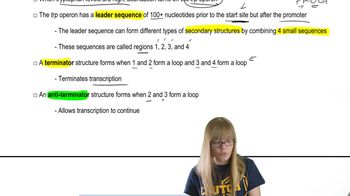The trpL region contains four repeated DNA sequences that lead to the formation of stem-loop structures in mRNA. What are these stem-loop structures, and how do they affect transcription of the structural genes of the trp operon?
Table of contents
- 1. Introduction to Genetics51m
- 2. Mendel's Laws of Inheritance3h 37m
- 3. Extensions to Mendelian Inheritance2h 41m
- 4. Genetic Mapping and Linkage2h 28m
- 5. Genetics of Bacteria and Viruses1h 21m
- 6. Chromosomal Variation1h 48m
- 7. DNA and Chromosome Structure56m
- 8. DNA Replication1h 10m
- 9. Mitosis and Meiosis1h 34m
- 10. Transcription1h 0m
- 11. Translation58m
- 12. Gene Regulation in Prokaryotes1h 19m
- 13. Gene Regulation in Eukaryotes44m
- 14. Genetic Control of Development44m
- 15. Genomes and Genomics1h 50m
- 16. Transposable Elements47m
- 17. Mutation, Repair, and Recombination1h 6m
- 18. Molecular Genetic Tools19m
- 19. Cancer Genetics29m
- 20. Quantitative Genetics1h 26m
- 21. Population Genetics50m
- 22. Evolutionary Genetics29m
12. Gene Regulation in Prokaryotes
Tryptophan Operon and Attenuation
Problem 15
Textbook Question
Attenuation of trp operon transcription is controlled by the formation of stem-loop structures in mRNA. The attenuation function can be disrupted by mutations that alter the sequence of repeat DNA regions 1 to 4 and prevent the formation of mRNA stem loops. Describe the likely effects on attenuation of each of the following mutations under the conditions specified.

 Verified step by step guidance
Verified step by step guidance1
Understand the trp operon attenuation mechanism: The trp operon in bacteria is regulated by attenuation, which involves the formation of stem-loop structures in the leader mRNA. These structures depend on the interaction of regions 1, 2, 3, and 4 of the leader sequence. The formation of specific stem-loops determines whether transcription continues or terminates.
Analyze the role of each region: Region 1 interacts with region 2, and region 3 interacts with region 4. When tryptophan levels are low, ribosomes stall at region 1, allowing regions 2 and 3 to form an anti-terminator stem-loop, which permits transcription. When tryptophan levels are high, ribosomes do not stall, allowing regions 3 and 4 to form a terminator stem-loop, halting transcription.
Evaluate the effect of mutations in region 1: If region 1 is mutated, ribosome stalling may be disrupted. Under low tryptophan conditions, this could prevent the formation of the anti-terminator (regions 2-3), leading to premature termination. Under high tryptophan conditions, the terminator (regions 3-4) may still form, so transcription termination would likely proceed as usual.
Evaluate the effect of mutations in region 2: If region 2 is mutated, it may not pair with region 1 or region 3. Under low tryptophan conditions, the anti-terminator (regions 2-3) may fail to form, leading to premature termination. Under high tryptophan conditions, the terminator (regions 3-4) may still form, so transcription termination would likely proceed as usual.
Evaluate the effect of mutations in regions 3 and 4: If region 3 is mutated, it may not pair with region 2 or region 4. Under low tryptophan conditions, the anti-terminator (regions 2-3) may fail to form, leading to premature termination. Under high tryptophan conditions, the terminator (regions 3-4) may fail to form, allowing transcription to continue. If region 4 is mutated, the terminator (regions 3-4) cannot form under high tryptophan conditions, leading to continued transcription regardless of tryptophan levels.
 Verified video answer for a similar problem:
Verified video answer for a similar problem:This video solution was recommended by our tutors as helpful for the problem above
Video duration:
2mPlay a video:
Was this helpful?
Key Concepts
Here are the essential concepts you must grasp in order to answer the question correctly.
trp Operon and Attenuation
The trp operon is a group of genes in bacteria that are involved in the biosynthesis of tryptophan. Attenuation is a regulatory mechanism that controls the transcription of the trp operon based on tryptophan levels. It involves the formation of specific mRNA structures that can either promote or terminate transcription, depending on the availability of tryptophan.
Recommended video:
Guided course

Trp Attenuation
Stem-Loop Structures in mRNA
Stem-loop structures are secondary structures formed in RNA molecules, crucial for the regulation of gene expression. In the context of the trp operon, the formation of these structures in the mRNA can lead to either the continuation or termination of transcription. The specific arrangement of regions 1 to 4 in the mRNA determines whether a transcription termination signal is generated.
Recommended video:
Guided course

Ribosome Structure
Impact of Mutations on Transcription Regulation
Mutations in the DNA sequence of the trp operon can disrupt the formation of stem-loop structures, thereby affecting the attenuation process. Depending on the location and nature of the mutation, the ability of the mRNA to form the necessary structures will change, influencing whether transcription is terminated or allowed to proceed. This can lead to altered levels of tryptophan synthesis in response to varying tryptophan concentrations.
Recommended video:
Guided course

Eukaryotic Transcription
Related Videos
Related Practice
Textbook Question
491
views


